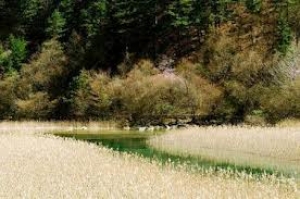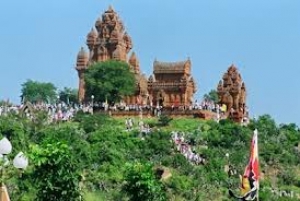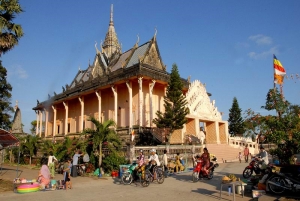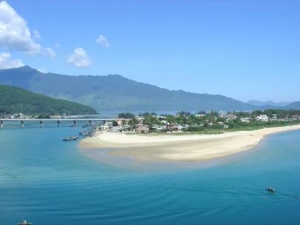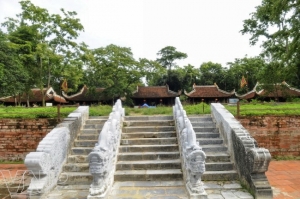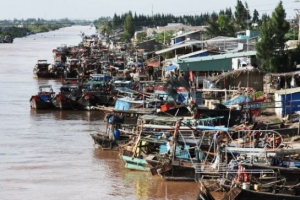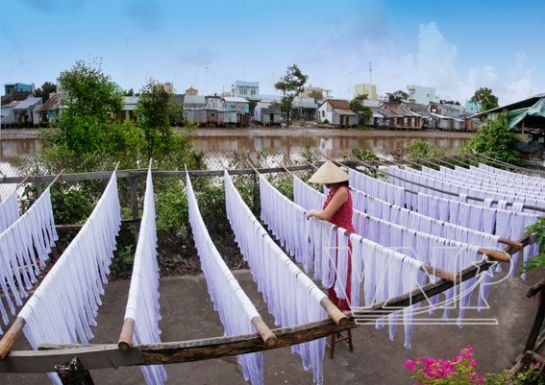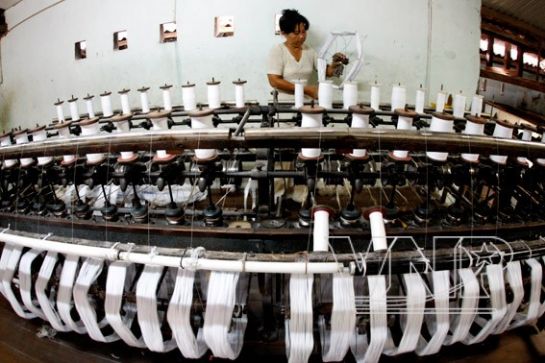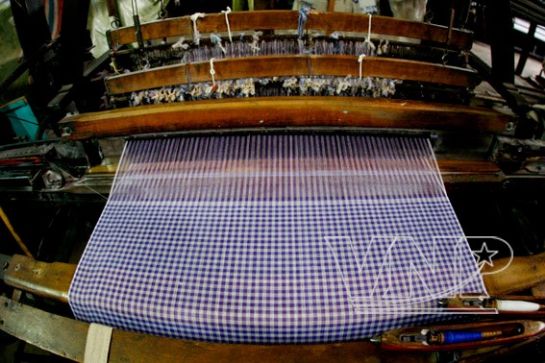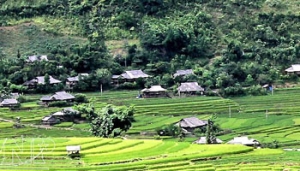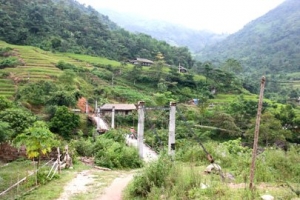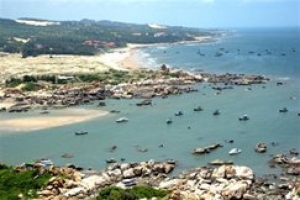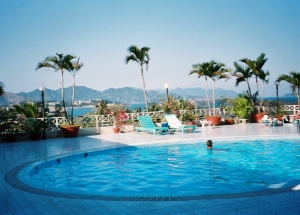
Asia Pacific Travel Team
Another wild flower in ethnic flower garden - The Bo Y
Have you known about a custom the women often sit when they deliver yet? Funeral custom, the dead are fired four rifle shots before the funeral?...Those are unique, special customs only the Bo Y have. Knowing about the Bo Y Ethnic Group, you will have interest experiences about Vietnamese culture.
Proper name: Bo Y
Other names: Chung Cha, Trong Gia.
Population: 1,420 people
Local groups: Bo Y and Tu Di
Language: The Bo Y group speaks Tay-Thai language (which belongs to the Tai-Kadai language family while the Tu Different speak Han or Chinese language family).
History: The first Bo Y people traveled south to Vietnam from China about 150 years ago.
Production activities: The Bo Y people were originally experienced in wet rice cultivation. However, since settling in the northern mountainous regions of Vietnam, they have had to rely mainly on slash-and-burn agriculture-primarily growing corn, their main crop. In addition, each family usually has a vegetable garden. Apart from raising livestock and poultry, the local people are also involved in various crafts such as cloth weaving, black-smithing, pottery-making, stone carving, silver engraving, plaiting and woodwork, etc.Clothing: Formerly, Bo Y women wore full skirts like those worn by Hmong, or ornamented with batik bee’s wax designs and dyed indigo. The blouse is short, often having five panels with a bodice covering the chest and abdomen. Silver ornaments are popular, such as necklaces, wrist chains and ear-rings. The women wear their hair wound in a chignon at the top of their head. Their headgear is traditionally an indigo turban which or ornamented with colorful embroidery. Nowadays, some Bo Y people have adopted the neighboring Nung’s way of dressing. Some also wear shirts lie the Han but with removable sleeves.
Lifestyle: The Bo Y live in Quan Ba (Ha Giang province) and Muong Khuong (Lao Cai). They live in houses built on the ground with a thatched, wooden or tiled roof and clay walls. The house usually has three sections, with an extra bay for the unmarried boys or used as a rice granary.
Social organization: The society’s social classes are clearly defined. The upper classes consisted of the village chief (known as Pin Thau) and his assistant (Xeo Phai)
Marriage: There are three steps involved to organise a Bo Y wedding:
Step 1: The boy’s family sends two female matchmakers to ask the girl’s family for her personal information, date of birth, so tht match-making calculations can be made. The girl’s family, in return, often shows their good-will by offering the guests 10 red colored chicken eggs. If the boy’s family finds that the couple is well-matched, then they will again send two matchmakers-this time male to read the horoscope of the girl and to consult the girl’s family on the price for an engagement ceremony.
Step 2: After the engagement ceremony, the marriage is agreed by the boy’s and the girl’s families.
Step3: The wedding. The bride-groom’s family presents the wedding presents to the bride’s family. Apart from food, some clothes for the bride are also included. The bridegroom does not go to the bride’s house; instead, the bride rides on a horse to the bridegroom, attended by the bridegroom’s sister who walks alongside. She brings with her a pair of scissors and a small hen, which she will release to the forest at mid-way.
Birth: In the past, according to local customs, the women often sit when they deliver. They cut the baby’s umbilical cord with a bamboo knife and the placenta is often buried right under the bed. Three days later, a ceremony is held for the goddess, believed to be the creator and protector of the baby, and also to nickname the baby. Only when the child reaches two or a tree year is he or she given an official name. It a child is ailing all the year round, a foster father will be chosen so that the child’s spirit has a place to rest.
Funerals: Funerals reflects the sentiments of the living towards the dead, which, according to Bo Y beliefs, will take the deceased’s sprit back to his or her country land. Four rifle shots are fired before the funeral, and the deceased’s feet should go first as the coffin is carried to the grave yard. Between the deceased’s home and the grave yard, three stops are made (if the deceased’s wife or husband is still living) or four (if both have died). Mourning is maintained by the family members for three years, during which time, the men are not allowed to drink wine, the women can not wear ornaments, and boys and girls are not allowed to get married.
Beliefs: Three incense bowls are placed on the altar, which is dedicated to heaven, to the spirit of the heart, and to ancestors. Under the altar, three is an incense bowl dedicated for worshiping the land’s god. If the wife’s parents both died without a son, the son-in-law is responsible for setting up a small altar in the doorway.
Festivals: There are many Tet occasions celebrated by the Bo Y, such as Nguyen Dan (Lunar New Year), Ram Thang Gieng (mid-lunar-January festival), 30th of Lunar January festival, Han Thuc, Doan Ngo, 6th of Lunar June, mid-Lunar-July and New Rice festival, in particular, is held on the 8th or 9th day of Lunar September, featuring the square sticky rice cake, chay cake and colored steamed rice.
Calendar: The Bo Y calculate the date based on the lunar calendar.
Education: In the past, some Bo Y people still used Chinese for writing their family annals, their ritual texts, and their destiny accounts sheet.
Artistic activities: In the Tu Di group, the youth often take part in exchanging songs sung at the beginning of the spring marketplaces or at their homes. Most songs are in Chinese, accompanied by ken la, a wind musical instrument made of leaves.
Games: On special occasions, the Bo Y play folk games with swings, Chinese chess, spinning top, and khang playing.
The Cham ethnic group - The ethnic group has the great cultural heritage
The Cham people live long time on land ranges in Central Vietnam. From local sources, the reform of the external factors, the Cham had created a diversified and orginal culture. Architectural heritage temples, massive sculptures and tradition dances of the Cham are large cultural values having great contribution for Vietnamese culture.
Other name: Cham, Chiem, Chiem Thanh Cham Pa, Hoi, etc
Local groups: Cham Hroi, Cham Poong, Cha Va Ku and Cham Chau Doc.
Population: 98,971 people
Language: Cham language belongs to the Malyo-Polynesian language family.
History: The Cham, who have lived along the coast of central Vietnam for a long time, possess a rich culture profoundly influenced by Indian culture. Until the 17th century, the Cham had successfully maintained their own nation, known as Cham Pa. The local population is composed of two groups: those living in Ninh Thuan and Binh Thuan believing in Brahmanism, with a smaller group following Bani (old Islam). Those residing in Chau Doc, Tay Ninh, Dong Nai and House Chi Minh City follow what is referred to as new Islam.
Production activities: The Cham have a tradition of wet rice cultivation. They are experienced in intensive farming and gardening and use irrigation. Apart from wet rice cultivation, the Cham also cultivate an annual crop of rice on dried swidden fields located on the mountainsides. Meanwhile the economy of the Cham living in the South is characterized by fishing, agriculture, textile weaving and small-scale enterprise. Handicrafts are fairly well-developed, especially silkworm textiles and handmade pottery wares that are baked in open kilns. The Cham engaged early on in external trade with other population, as the central coast used to be a busy hub for commercial transactions by famous merchant ships.
Diet: The Cham eat rice cooked in large and small earthen pots. It is often accompanied by fish, meat and bulb vegetables, which are obtained from hunting, gathering, husbandry and agricultural production. Popular drinks are rice and can (pipe) wines. Betel chewing is very important to people’s daily life and traditional rituals.
Clothing: Both men and women wear long one-piece sarongs or cloth wrappers. Men wear shirts fastened down the center with buttons, while women wear long-sleeved pullover blouses. The main color of their daily dress is cotton white. Nowadays, the Cham dress like the Viet in other parts of central Vietnam, with long-sleeved blouses which is only worn by elderly women.
Lifestyle: The majority of Cham live in Ninh Thuan and Binh Thuan. They build their houses on the ground, with the rooms being arranged according to a particular order: the sitting room, rooms for the parents, children, and married women, the kitchen and warehouse (including the granary), and the nuptial room of the youngest daughter.
Transportation: Te chief means of transporting goods and produces is the back-basket. The Cham are also expert boat builders, which serves river and sea fishing. They also make heavy-weight buffalo carts for transporting large quantities of goods by land.
Social organization: The Cham family is traditionally matriarchal, though in the past Cham society was a feudal one. In areas where people follow Islam, the family structure may be somewhat patriarchal, although traces of matriarchal still exist in family relationships and ancestors worship. The local population was originally divided into two major family lineages, including Cau and Dua, such as the Nie and Mlo of Ede then became a working class, while the Dua was the class of aristocracy and priests. Under each lineage were the mother-governed sub-lineages, always headed by an aged woman, of the youngest lineage. The lineages can have numerous family branches. The ancient Cham society also set out ranks for different social classes, including that of the ancient Indian society. The social classes lived in different areas, and there were certain barriers between them that prevented cross-marriage, co-existence in the same village, eating from a shared tray of food.
Marriage: Cham women take the initiative in marriages. The couple lives with the wife’s family, and children are named after the family name of the mother. Wedding gifts are prepared by the bride’s family. Monogamy is a principle of all marriages.
Funerals: Cham traditions have two forms of sending the deceased to the world beyond: burial and cremation. Brahmanists often cremate the deceased according to their religious principles, while other Cham bury their loves ones. Members of the same family lineage are buried in the same place as their mother.
Building a New House: the Cham living in Ninh Thuan and Binh Thuan believe that they have to perform certain religious rituals before the building of a new house, particularly praying for the land’s god and asking for his permission to cut down trees in the forest. A ritual is also held to receive the trees when they are transported to the village. A ground-breaking ceremony called phat moc is also held.
Festivals: Various agricultural rites are performed each year. These include ceremonies for the opening of a canal and embankment, for young rice, for the appearance of paddy ears. The most important event, called Bon Kate, is held by the Cham towers in the tenth moth of the lunar year.
Calendar: The Cham make their agricultural schedule based on the lunar calendar.
Education: The Cham developed their own writing system early. Many literary works written on stelae and ancient manuscripts are still preserved today. The Cham script is based upon Sanskrit, but its use is limited to the upper classes of the aristocracy and priests. Instruction and professional training is essentially transmitted orally and by memorization.
Artistic activities: Among the more striking Cham musical instruments are their drums with leather drum heads, called Paranung, cylindrical drums, and the xaranai clarinet. Cham folk songs and ancient Cham music have influenced considerably the music and folk songs of the Viet people in the central parts of Vietnam, particularly cylindrical drum music, songs relating sad or tragic stories, and traditional songs of Hue. Traditional Cham dances are also found in the important annual event of Ban Kate held by the Cham towers.
Games: Children are font of games such as kite flying, mock combats, flag seizing, hide and seek, etc.
Xiem Can- The Largest Pagoda in Bac Lieu Province
Xiem Can Pagoda is situated 7 kilometers to the south of Bac Lieu town, on the same road that leads to the Bac Lieu Bird Sanctuary. This most beautiful pagoda is also considered the largest in the region. The pagoda was constructed in 19th century with a very special architecture style.
Tourists in Vietnam travel can see the similarities between the architecture of Xiem Can pagoda and those of Cambodia’s. That’s true! The pagoda is designed with Angkor architecture and featured by unique patterns on domes, walls, pillars, and staircases. Khmer people believe that there are challenges to Buddhists on the way to be rewarded for a devout life. That’s why there are embossment of female fairies and monsters on the pillars. They can also see images of snakes carved on domes and staircases, which proves that the Great Buddha had used his mercifulness to convert dangerous animals like snakes. Sanctum places of Khmer people often face East as they believe that the journey of being rewarded for a devout life and to be a Great Buddha is from West to East.
Khmer people highly appreciate togetherness. The pagoda is both a holy and a friendly place. The pagoda functions as a community house where they can receive help and safety. Visitors in Vietnam travel can realize the great aestheticism of the pagoda, which is expressed through the decoration patterns. On the roof of the pagoda, there is the image of Angkor Wat temple, from which the Khmer architecture originates.

Visiting the pagoda in Vietnam tourism, visitors will not only be impressed by the imposingly splendid beauty of Xiem Can pagoda, but also by the great hospitality of locals, who are truly sincere, industrious and creative. The pagoda has been constructed through generations of locals, who have worked hard to complete this sacred place.
For tourists in Vietnam travel, it is even much more exciting to visit the pagoda during the festivals such as “Ok Om Bok”, “Chol Chnam Thmay”, “Don Ta”. They special and unique cultural features of Khmer people have contributed to the diverse Vietnam culture, making the country the land of rich traditional and culture which can never be dissolve.
Smile Travel Vietnam launches many attractive tours in Danang
To meet the increasing need of people who want to visit Vietnam, many travel agencies have been emerging. Among them, Smile Travel Vietnam is known as one of the top sites for international tourists. At the moment, the company is launching many special programs, which offers tourists with discounted tours and high quality services. Noticeably, Tours in Danang are discounted at 30-50% depending on each package. This is also the time for tourists to get surprisingly cheap tours, ranging from a 1-day package to a 1-month package. Besides, using the service of Smile Vietnam Travel, customers are also offered with other great services including tour guides, hotels, airline tickets, visas, and so on.
The fact is that Smile Travel Vietnam is making its ongoing effort to attract more and more customers and it is giving importance to outstanding beauty spots in Vietnam. Danang is one of the most significant tourist hubs in Vietnam, thanks to its enchanting beaches with fine and clean sand and clean blue water.
Ranking after Hanoi, Ho Chi Minh City, and Hue, Danang is the fourth largest city in Vietnam. However, it possesses the natural and peaceful beauty as if it has never been an urban area in a developing country. Such historical relics as China Beach, Lang Co Beach, Hoi An Old Quarter, and My Son Holly Land are destinations of thousands of foreign tourists every year. Lang Co Beach, a peninsula surrounded with a sparkling lagoon and the long coast, is also highlighted with white sandy beaches, crystal-clear water, and palm trees. Besides, Danang coastline has been long well-known due to its cool water and sport activities such as fishing, water-skiing, diving, and yachting. It is said that Danang is the combination between man and nature, tradition and modernity. Lying beside Han River, the city is at its most enchantment at the sunset. Moreover, tourists will have opportunities to see a variety of natural animals and creatures within a modern city.
Situated between Ha Noi Capital and Ho Chi Minh City, Da Nang owns the spectacular sight of Hoi An old quarter and the charm of imperial capital Hue. The coastal city is the harmonious combination of traumatic past and high-rise future, geographic favor and honest residents and owns various cultural and architectural heritages.
Incredibly, though living in the crucial tourism attraction, local people are famous for the hospitability and honesty. As mentioned previously, Da Nang lies by poetic Han River, beautiful stretching beaches of Eastern Sea, consisting of many distinctive spots. They are Cham Museum, Marble Mountains, Son Tra Peninsula, Da Stream and Ba Na Ecotourism resort, Mo Stream, which leave tourists unforgettable impression and memories.
Water sport activities here are lively all the time, especially on weekends. Not just having the traditional beauty, Danang is renowned for its great hotels, restaurants, and shopping centers. However, hotels can range from cheap to luxurious ones, all of which are ensured in quality. Cuisine is also an outstanding feature that makes Danang attractive. Coming here, people will be impressed by such specialties as wheat, pork, cake, beef, sauce, and sesame bread.
Danang, with its own magic enchantment, is the paradise of many tourists. It is sure that tourists will have a great vacation once coming here. At this time, they will get big offers when booking tours in Danang with Smile Travel Vietnam. Then, tourists will have chances to get discounts up to 50 %. The tour of Danang – Hoi An in 1 day just costs only $35-$122. Besides, there are different Tour Packages on the website that are available for booking. Tourists can pay a visit to the official website of Smile Travel Vietnam to get more details.
Lam Kinh - A well-known historic relic
To reach the central area of the royal citadel, visitors pass over a stone bridge crossing the Ngoc River. Walking for about 50m, tourists see a green plot of grass and an ancient well with clean and clear water. Next is the southern gate with a 300-year-old banyan tree covering up the roof of the gate and then a dragon yard. Passing the dragon yard, tourists come to the central palace where kings gave audience and discussed state affairs.

From the central area of the royal citadel, on the roads paved with red bricks to forests tourists visit the tombs of kings in the Le Dynasty under green leaf canopies or climb up to the windy Dau Mountain and enjoy Tay Lake with its wild and poetic beauty.
Visiting the relics on August 22 of the lunar calendar, tourists not only enjoy a beautiful landscape and learn about the culture, architecture and history of this land but also participate in the Lam Kinh Festival with many traditional folk games. The festival is annually held on King Le Thai To’s death anniversary to commemorate his glorious achievements.
A pay to visit to Bac Lieu
Bac Lieu borders Hau Giang and Kien Giang Provinces . It was once a locality with a rich tradition of artistic performance and was one of the cradles of “Don ca tai tu”, a folk performing form used in festivals, wedding ceremony or simply during moon-lit nights in the villages and hamlets.
Bac Lieu people are soft-hearted and have a great love for their country and native place. The song “Da co hoai lang” composed by Cao Van Lau is full of human love and exists forever in the hearts of all people, especially the natives of the Cuu Long River delta, wherever they are living.

The floating market is a typical cultural feature of Bac Lieu.
The typical image of the villages in Bac Lieu is interlacing alluvial canals with verdant water coconut trees. Bac Lieu people mainly use water-way transport. While sitting on a canoe or motor-boat visitors can enjoy a stream of fresh air over the canal, contemplate the vast sky and talk with simple and frank rural people.
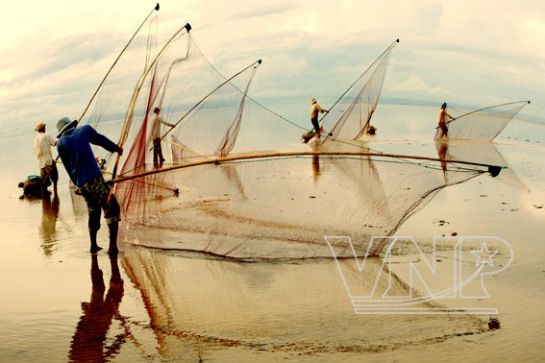
Catching mussels along the coastline of Bac Lieu Town is a traditional occupation which helps many farmers escape poverty.
Bac Lieu is renowned for salt-making which has existed for a long time, supplying a large amount of salt for the Cuu Long River delta. Salt fields are divided into squares and rows, making a nice scene. Bac Lieu edible salt, which is known for good quality and is favoured by families, is exported to Japanese market.
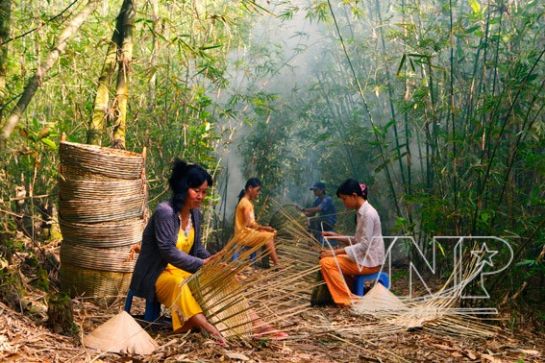
In the suburbs of Bac Lieu Town, long-standing traditional craft villages
make woven bamboo items, which helps improve the life of the local farmers.
Bac Lieu also has many craft villages engaging in making woven bamboo products, weaving fishing nets and making fish sauce and soy sauce. Coming to this area, visitors will see artisans sitting under the shades of bamboo trees or plants to make woven products.
In the coastal villages the craft of making fishing-nets has developed to meet the fishermen’s demand. It is a painstaking job because the firm nets are woven manually. Being once a wild forest area which was reclaimed in the early 19th century, Bac Lieu has a simple culinary style, with the dishes mainly being grilled or boiled.
There are many local delicious dishes, such as Mam kho hot pot with wild vegetables, sour eel hot pot, snake-head fish grilled in rice straws, braised fish served with pickled vegetables, peppery vermicelli and beef, rice pancake, fried anabas served with fish sauce and ginger, dried shrimp served with pickled scallion heads, lotus root salad with boiled shrimp, etc.
Weaving towels and mosquito nets has long been practised in Bac Lieu Town.
The products are much sought-after in the southern rural areas.
In particular, oysters, snails and mussels are abundant and cheap. The most delicious are dishes made from snake, tortoise, crab and oyster, which bear specific identities of Bac Lieu cuisine that no other places have.
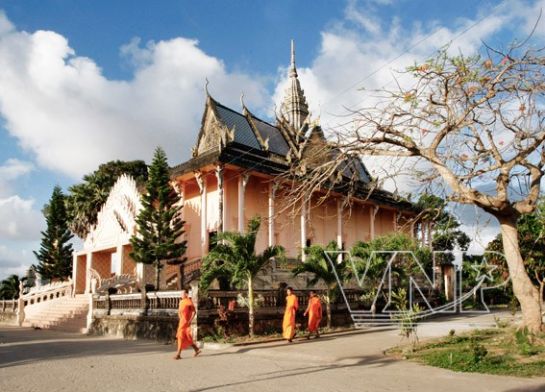
Xiem Can Pagoda of the Kh’mer ethnic people was built in 1887.
The garden of old longan trees in Bac Lieu is the most renowned orchard in the Cuu Long River plain, attracting a lot of visitors. It covers about 230ha, stretching along a distance of 11km through Hiep Thanh and Vinh Trach Dong Communes of Bac Lieu Town.
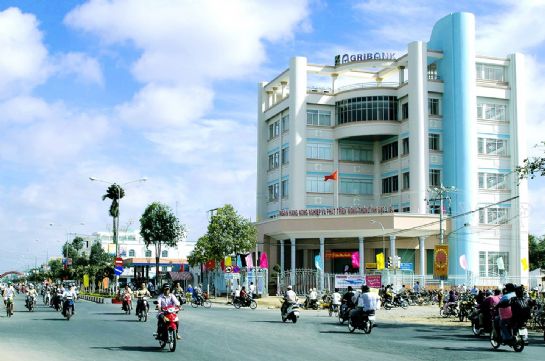
Streets in Bac Lieu Town are being upgraded.
According to the local people, Bac Lieu longan garden was established more than 100 years ago. Legend has it that Truong Hung was the first man to bring the longan strains of Su-bic and Tu-huyt from abroad to grow on the sandy land in Bac Lieu.
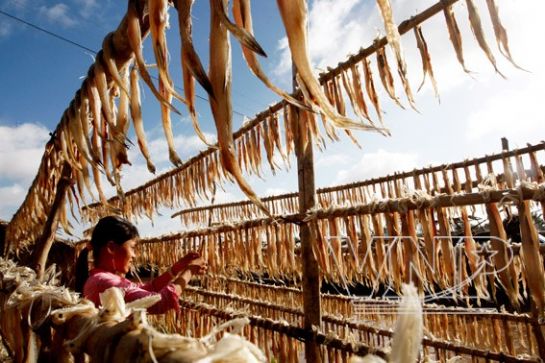
Drying fish at Bac Lieu wharf.
The Su-bic strain yields big fruit which has a thin skin, thick pulp, sweetness and lovely fragrance. The Tu-huyt strain yields small fruit which has a small pit, thick pulp and is sweet. Both strains have adapted to the soil and developed well, particularly the Su-bic strain which is much sought after. According to the estimation by longan growers, on average, each old longan tree yields 300-400kg of longan per crop.
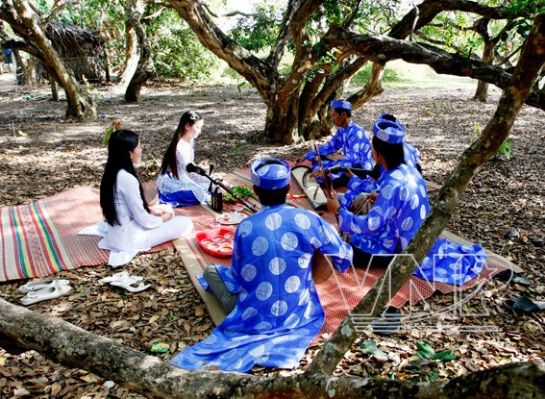
The famous song “Da co hoai lang” composed by Cao Van Lau is much loved by Bac Lieu people and it is often performed by local amateur artists to entertain tourists.
If the price of longan increases to 8,000-10,000 VND per kilo, a household engaged in growing longan trees can earn tens of millions of VND a year, even some households can earn hundreds of millions of VND. To restore and preserve the old longan garden, Bac Lieu Town is coordinating with the tourism sector to work out a project on developing the longan garden for eco-tourism and cultural tourism purposes. In recent years many families in Hiep Thanh and Vinh Trach Dong Communes have reinvested in their longan gardens to open tourist sites.
Coming to Bac Lieu, visitors will be lured by this beautiful place and will remember the typical specialties of a southern watery area and have affection for the local people who are good-natured, honest and hospitable.
Ang Village - A water-color painting of Northwestern mountains
Located in Moc Chau Plateau (Moc Chau District, Son La Province), Ang Village has fresh and cool air, charming scenery and also preserves special culture treasures of Thai ethnic group.
Near to the village is natural lake with the area of 5ha surrounding by green pine forests. In the distance, there are verdant tea hills, grass fields; especially in the spring, white flowers of apricots, plums, ban (a typical flower of Northwest region) blooming throughout the forests. All seem to emphasize the beauty of Ang Village more sparkling, charming.
Ang Village is home to Thai ethnic people. They mainly live by planting (tea, vegetable, corn, rice), poultry and cattle husbandry and traditional crafts (brocade weaving, knitting). Although near Moc Chau Farm Town, villagers in Ang Village has kept intactly traditional culture identity as architecture of traditional stilt houses, costume, old folk songs, folk games, specific festivals (Het Cha festival, new rice festival)...
In recent years, for sustainable tourism development associated with conservation and promotion of natural beauty, culture in Moc Chau, Son La Province has invested to exploit eco and community-based tourism type in some ethnic minority villages, of which including Ang Village. With Northwestern natural scenery and unique culture of Thai people, Ang Village has became an attractive destination for many international and domestic tourists, contributed to improving lives of villagers as well as preserving and promoting traditional culture identity. Currently, brocade products (pieu handkerchiefs, com shirts, handbags, curtains, tablecloths…) of villagers with various designs and exquisite patterns are creating gradually own brand.

Pine forest in Ang Village
To Ang Village, tourists will have opportunity to experience the daily life of villagers; discover Northwestern mountains scenery, especially ride horses to visit Ang Village pine forest, enjoy local specialties as can wine, com lam (rice in bamboo tube), pa pinh top (grilled fishes), bacon…
Recently, Moc Chau District has planned Ang Village, the lake and pine forests into a tourist area with the area of 62ha and calling for investment to further develop tourism. In the future, this tourist area will become a must-see destination of tourists on the North West arc road.
The night at Dao Village
Just spending one night with a Dao minority family is a great experience for tourists. In the Nam Choong village of Xin Man Commune, Ha Giang Province, tourists can do just that as they can easily find a cozy homestay for the night and enjoy the hot spring that runs through the village during the day as they experience the daily routines of Dao people.
Xin Man Commune is located in the north-west area of Ha Giang Province but tourists can reach it from the city of Ha Giang or Lao Cai.
Nam Choong village is special not only thanks to the hot spring, but also because it’s the living place of Dao Ao Dai and its villagers still keep the old traditions alive on a daily basis.

The hosts will serve lunch and dinner according to visitor’s request. Normally meals will include chicken, pork, buffalo, fish and vegetable dishes
Ke Ga Lighthouse – A must-see attraction in Binh Thuan
Ke Ga Lighthouse, located on Ke Ga Island about 30 kilometers south of Phan Thiet City, is a must-see attraction in Binh Thuan Province where visitors can experience a fabulous panoramic view of the open sea. Ke Ga Lighthouse, a popular destination in Phan Thiet, was built in 1899 and attracts a large number of tourists. The stairs that have existed for over 100 years take tourists to the top for a panoramic view of the island.
Ke Ga Lighthouse, located on Ke Ga Island about 30 kilometers south of Phan Thiet City, is a must-see attraction in Binh Thuan Province where visitors can experience a fabulous panoramic view of the open sea.

Built in 1899, the lighthouse is not only an historical relic but also an attractive destination for visitors.
To reach the lighthouse, tourists can travel by bus or motorbike along the coast to Ke Ga Island or take a canoe from Phan Thiet City or from Vinh Hy Bay, Nha Trang City. At the lighthouse, tourists can hire a fishing boat priced at VND100,000 with a capacity for four people. Visitors can also stay on the island overnight for a spot of fishing which is an unforgettable experience.
The panoramic view of Ke Ga Island from the lighthouse Tourists take a cruise on a fishing boat to reach the lighthouse.
The lighthouse with its unique architecture is about 60m tall. From that height, visitors are able to see a vast expanse of sea and sky, as well as enjoy cool ocean winds. The most beautiful moment to visit the lighthouse is at sunset.
Here are some snapshots taken by The Saigon Times Daily’s photo-journalist Kinh Luan, capturing the beauty of the lighthouse.
The best time for traveling to Nha Trang
The weather in Nha Trang is warm and comfortable anytime during the year can be favorable for a trip to the tourism city. In summer often lasts from May with sunlight and hot weather, suitable for natural tourism such as ecotourism, ocean tourism or water sports; while the other months could be pleasing for tourists to visit cultural and historical places such as Ponagar Temple Tower, Vinpearl or The Nha Trang Aquarium.
While most of the South of Vietnam is turned into water for half of a year by monsoon winds, Nha Trang experiences only four “wet months”, from September till mid-December, which are also a time to reconsider visiting Nha Trang. In the first eight months of the year, this coastal city enjoys a warm and beautiful weather and so any day between January and August is good time to start your holiday in Nha Trang.
Though long dry season gives beach lovers a big time budget to enjoy the sun-sea-sand in the area, tourists are advised to visit here before the late of June to avoid high humidity and tropical heat in two hottest months of the year (July and August).
The best time to visit Nha Trang would be from February till April, when temperature is kept around 26-27 degree Celsius, and precipitation stay at the lowest level of the year. Spring months are also the best time to dive here. Some coral-rich dive sites that diving enthusiasts should not miss out on are Small Hill, South Reef, and Moray Beach After, all around Mun Island.
If your trip is scheduled for July or August, remember to give Hòn Bà (30 km far from city center) the first position on your tourist attraction list. The mountain with cool climate all year round is absolutely a great place to hide from the summer heat.
Autumn travel in Nha Trang is not recommended. Though it is not cold, rainy, tropical storm and typhoon may annoy most of tourists. Visitors in Vietnam tourism planning to visit the area from September till December should keep your eyes on the local weather forecast.


